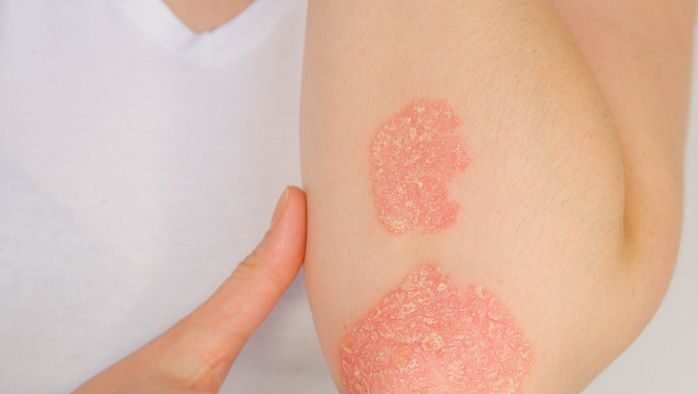Beyond the Skin: The Battle with Psoriasis
Psoriasis is a chronic inflammatory skin disease that can also affect the nails and joints. Two percent of the world’s population is impacted by it, and regardless of age or color, it can affect both men and women equally. In Indonesia, 2.5% of the population is affected by the disease based on a journal published by Sari et al. just this year. Psoriasis is debilitating disease as it has a negative impact on the patient’s physical, mental, emotional, and socioeconomic well-being.

What Causes Psoriasis?
Psoriasis is an autoimmune condition where the immune system speeds up the cell growth causing patches of thick red skin and silvery scales. What exactly causes the immune system to be overreactive remains unknown, but genetics and the environment play a key role in the development of this condition. Common triggers for psoriasis include stress, illness (strep infections), injury to the skin, changes in body temperature due to weather, and certain medications.
What Causes Psoriasis?
- A patchy rash that varies widely in how it looks from person to person, ranging from spots of dandruff-like scaling to major eruptions over much of the body.
- Rashes that vary in color, tending to be shades of purple with gray scale on brown or Black skin and pink or red with silver scale on white skin
- Small scaling spots (commonly seen in children)
- Dry, cracked skin that may bleed
- Itching, burning or soreness
- Cyclic rashes that flare for a few weeks or months and then subside
What Are The Types of Psoriasis

Plaque Psoriasis. The most common type of psoriasis. It appears as dry skin plaques covered in scales and usually found on elbows, knees, scalp, and lower back, but could also be anywhere on the body. The plaques may itch, hurt, or have both. Your skin around your joints may crack and bleed if the condition is severe.

Nail Psoriasis. It impacts about 50% of Psoriasis patients. The nails may get small pits or dents, turn discolored, or grow out of control. It can also be separated from the nail bed and become loose and may crumble in extreme circumstances.

Guttate Psoriasis. This type of psoriasis affects children and teenagers and usually appears after a streptococcal throat infection. Small (less than 1 cm) drop-shaped sores on the chest, arms, legs, and scalp are signs of guttate psoriasis.

Inverse Psoriasis. The skin’s creases and folds are affected, including those in the armpits, groin, buttocks, and under the breasts. In some or all these areas, inverse psoriasis may result to large, smooth patches of skin and is mostly aggravated by sweating and friction and can be particularly uncomfortable in hot weather

Pustular Psoriasis. Affecting about 3% of people with psoriasis, this type of psoriasis appears in a form of pustules, which are painful, white, pus-filled bumps that may be encircled by inflamed or reddened skin. Pustular psoriasis may only affect certain body parts, like the hands and feet, or it may affect most of the body

Erythrodermic Psoriasis. This is a rare type and affects only about 2% of people with psoriasis. The skin may shed in thick sheets and become extremely red when flares up. It affects almost the entire body and can be fatal. Other signs include excruciating pain and itching, temperature and heart rate changes, dehydration, and nail changes. During an erythrodermic flare, it’s crucial to see a doctor right away.
Patients with moderate to severe psoriasis are more likely to experience psoriatic arthritis, heart disease, stroke, diabetes, anxiety, and depression. Unfortunately, there is no cure for psoriasis, but there are several effective treatments available.
How is Psoriasis Treated and Prevented?
Treatments for psoriasis aim to get rid of scales and slow the rapid growth of skin cells. Options include oral or injectable medications, light therapy, phototherapy, and creams and ointments (topical therapy).
The severity of the psoriasis and how responsive it has been to prior treatments and self-care techniques will determine which treatment options to follow. The patient might need to experiment with various medications or different combinations of treatments before arriving at an approach that works. The disease may return even after a successful treatment.
Psoriasis cannot be completely avoided. By strictly adhering to the doctor’s recommendations for treatment, leading a healthy lifestyle, taking care of the skin, and avoiding situations that might set off an attack of symptoms, one can lower the risk of having psoriasis.
As psoriasis is a chronic condition, the symptoms may come and go during the patient’s life and treatment can only relieve symptoms so that the patient can look and feel his/her best.
- Take medications as instructed
- Use moisturizer regularly, especially after bathing
- Avoid harsh soaps
- Use medicated shampoo for scales on the scalp.
- Discuss with healthcare provider about lowering the risk for related conditions, such as heart disease, depression, and diabetes.
- Lower stress with meditation, exercise or seeing a mental health professional
Is Psoriasis Contagious?
No, psoriasis is not contagious. The World Health Organization (WHO) recognized Psoriasis as a non-communicable disease in a resolution it enacted in 2014. It means the disease cannot be spread by being in contact with the person affected because its cause is merely attributed to genetics and overreactive immune system.
References:
Psoriasis | CDC. (n.d.). Retrieved October 27, 2022, from https://www.cdc.gov/psoriasis/index.htm
Psoriasis: What It Is, Symptoms, Causes, Types & Treatment. (n.d.). Cleveland Clinic. Retrieved October 27, 2022, from https://my.clevelandclinic.org/health/diseases/6866-psoriasis
Psoriasis – Symptoms and causes. (2022, October 8). Mayo Clinic. https://www.mayoclinic.org/diseases-conditions/psoriasis/symptoms-causes/syc-20355840
Psoriasis Resource Center. (n.d.). Retrieved October 27, 2022, from https://www.aad.org/public/diseases/psoriasis
Sari, D., Hany, A., Christanti, M., & Amalia, A. (2022). Correlation between Perception with The Needs of Structured Education for Psoriasis Patients during The Pandemic of COVID-19. Journal of Nursing Science Update, 10(1). https://doi.org/10.21776/ub.jik.2022.010.01.3
